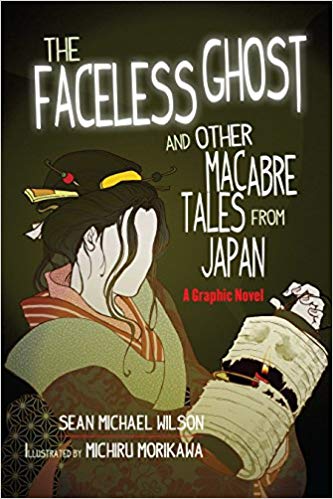
By Seán Michael Wilson & Michiru Morikawa (Shambhala Publications)
ISBN: 978-1-61180-197-2 (TPB)
If you read prose and love old stories you should really track down the works of Patrick Lafcadio Hearn, an Irish-Greek raconteur laterally renamed Koizumi Yakumo. They are wonderful and truly compelling. He was a pretty impressive character too, so you’d be best served to learn of his remarkable life too…
I’m not certain how the socially pioneering teacher, journalist, historian, translator and archivist would react to seeing some of his most engaging works translated into graphic narratives but as a renowned breaker of borders and flouter of taboos, I suspect he’d approve, even if this gleefully wry collation hadn’t been produced by such stellar luminaries as Scottish author Seán Michael Wilson (Breaking the Ten and Portraits of Violence – An Illustrated History of Radical Thinking) and his frequent collaborator Michiru Morikawa.
Wilson’s life has some parallels with Hearn’s. The Japan-based writer, educator and dedicated Humanist has written political and philosophical tracts such as Goodbye God – An Illustrated Examination of Science Vs. Religion in graphic form and has adapted Western and Eastern literary classics such as Wuthering Heights, A Christmas Carol, Sweeney Todd, and Chinese classics Tao Te Ching and The Garden, as well as original genre pieces such as urban interacial romance The Story of Lee.
Illustrator and manga artist Michiru Morikawa won the 2005 International Manga and Anime Award before going on to illustrate Wilson’s books Buskers, Yakuza Moon, The Demon’s Sermon on the Martial Arts and Musashi, amongst numerous comics series.
Hearn visited Japan as a correspondent in 1890, and fell in love with the land and the culture. He ended his days there in 1904, after marrying, becoming a Japanese citizen, teaching in numerous schools and universities and introducing the western world to the exotic enigmatic East through his writings and translations of its myths and legends.
Absurdly accessible, the tales here are gathered from the nation’s feudal period and open with a samurai yarn dubbed ‘Diplomacy’, wherein a highborn executioner performs his onerous task and plays a subtle and crafty trick upon the imminently departed to ensure that there will be no repercussions from beyond the grave…
That mordantly amusing distraction then gives way to a classic ghost story in ‘The Snow Woman’, wherein a young woodcutter survives an icy encounter with a mystical spirit at the cost of a simple promise. Tragically, in all such stories, a keeping one’s word is always impossible and leads to appalling inescapable circumstances…
Vanity and dissatisfaction fuel the saga ‘Of a Mirror and a Bell’, after the priests of Mugenyama ask the local women to donate their bronze mirrors so they can be cast into a great bell. After complying, one farmer’s wife began to bitterly regret her actions and so intense were her feelings that the mirror could not be melted down.
Wracked with guilt for her shameful intentions and the spoiling of the bell, she took her life, triggering a concatenation of unfortunate events…
After the history-making final clash between Heike (Taira) and Genji (Minamoto) clans, the rulership of Japan was decided for centuries to come. However, the sea battle created thousands of ghosts and ‘Hoichi the Earless’ relates how a blind musician and bard was tricked and beguiled by these restless spirits until a Buddhist priest intervened.
The end result was not an unqualified success…
Straight, inescapable horror drives the brief yet potent tale of a luckless merchant who encounters ‘The Faceless Ghost’, whilst love and friendship inspire the story of a young man in need of bride who prospers after he graciously saves a shark spirit and is uniquely rewarded by ‘The Gratitude of the Samebito’…
As recounted in the ‘Author’s Note’ – detailing the origins and source material of the adaptions – the stories are mostly taken from Hearn’s books Kwaidan: Stories and Studies of Strange Things (1903) and Shadowings (1900), and come packed with sleek, informative and delightfully rambling diversions which add fabulously engaging context to the stories.
Eerie, exotic and wonderfully compelling, these “yokai†stories are gems of unease, disquiet and wonder that no lover of the strange can fail to adore.
© 2015 by Sean Michael Wilson. Illustrations © 2015 by Michiru Morikawa. All rights reserved.
